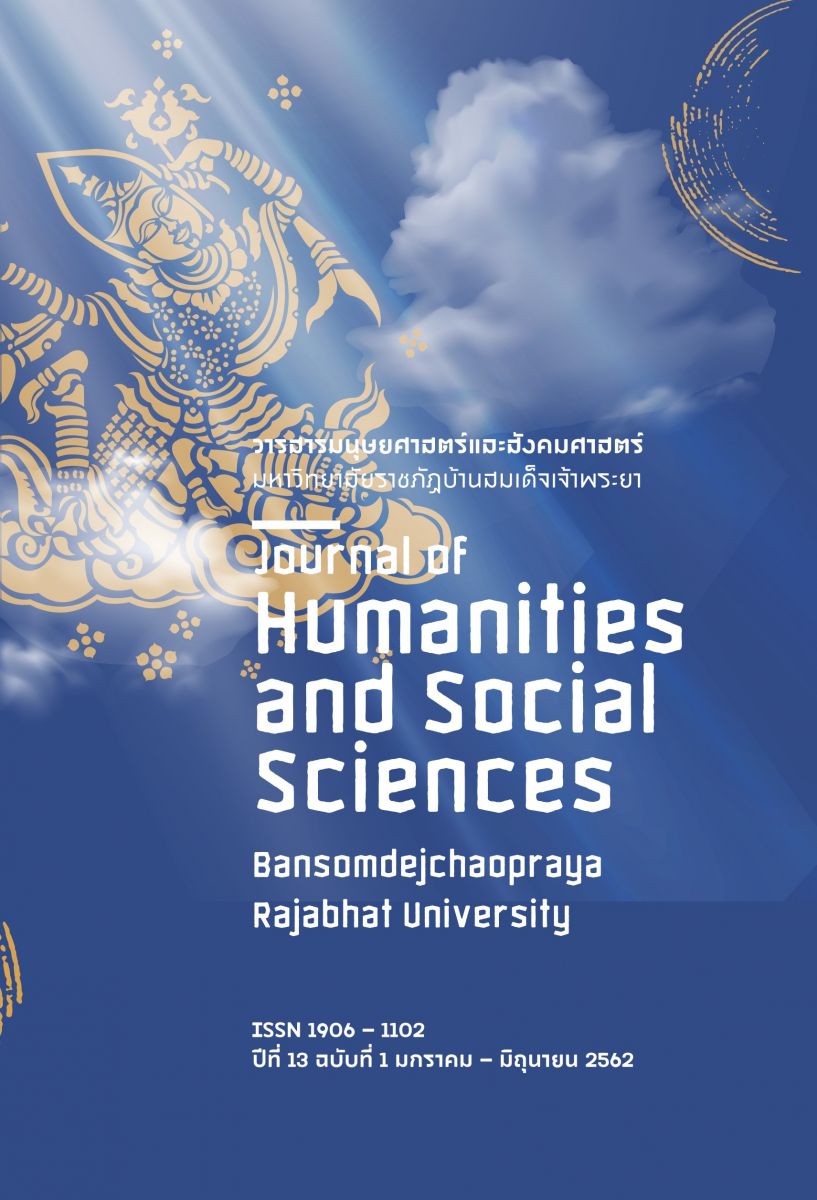การพัฒนาศักยภาพพื้นที่ท่องเที่ยวเพื่อแก้ปัญหาการรุกล้ำโบราณสถานในจังหวัดพระนครศรีอยุธยา
คำสำคัญ:
การรุกล้ำโบราณสถานอยุธยา, ศักยภาพพื้นที่ท่องเที่ยว, โบราณสถานบทคัดย่อ
การวิจัยนี้มีวัตถุประสงค์ คือ 1) เพื่อศึกษาบริบทพื้นที่ท่องเที่ยวโบราณสถาน จังหวัดพระนครศรีอยุธยา 2) เพื่อกำหนดแนวทางการพัฒนาศักยภาพพื้นที่ท่องเที่ยวเพื่อแก้ปัญหาการรุกล้ำโบราณสถานในจังหวัดพระนครศรีอยุธยา โดยใช้กระบวนการวิจัยเชิงคุณภาพจากการสัมภาษณ์เชิงลึก เลือกกลุ่มตัวอย่างแบบเจาะจง ใช้แบบสัมภาษณ์กึ่งโครงสร้างกับภาครัฐ ภาคเอกชนและผู้แทนชุมชนที่มีส่วนเกี่ยวข้องกับแหล่งท่องเที่ยวในจังหวัดพระนครศรีอยุธยา จำนวน 21 คน วิเคราะห์ข้อมูลเนื้อหา และกระบวนการวิจัยเชิงปริมาณ จากการเก็บแบบสอบถามเพื่อประเมินระดับความสำคัญต่อแนวทางการพัฒนาศักยภาพพื้นที่ท่องเที่ยว เลือกกลุ่มตัวอย่างแบบบังเอิญ จากนักท่องเที่ยวชาวไทยที่เดินทางท่องเที่ยวในเขตโบราณสถานจังหวัดพระนครศรีอยุธยา จำนวน 400 คน วิเคราะห์ข้อมูลโดยใช้สถิติเชิงพรรณนา ด้วยการหาค่าร้อยละ ค่าเฉลี่ย และค่าเบี่ยงเบนมาตรฐานการศึกษาบริบทพื้นที่ 3 ประเด็นสำคัญ พบว่า 1) ประเด็นความโดดเด่นของพื้นที่มรดกโลกพระนครศรีอยุธยา คือการเป็นอดีตราชธานีไทยที่เจริญรุ่งเรือง เป็นแหล่งศิลปวัฒนธรรมของชาติและโบราณสถานที่คงเหลืออยู่แสดงให้เห็นถึงความเจริญในอดีต 2) ประเด็นการอนุรักษ์โบราณสถาน ในปัจจุบันพื้นที่ดังกล่าวเป็นแหล่งชุมชนและศูนย์กลางทางเศรษฐกิจการท่องเที่ยว จึงเกิดเป็นแหล่งเสื่อมโทรมและเกิดการรุกล้ำเขตโบราณสถาน 3) ประเด็นสถานการณ์สำคัญในพื้นที่โบราณสถาน พบสถานการณ์ 4 ด้าน ได้แก่ ด้านพื้นที่ ด้านปัจจัยพื้นฐานทางการท่องเที่ยว ด้านการสร้างองค์ความรู้ ด้านเศรษฐกิจและความปลอดภัย ผลการศึกษาดังกล่าวสามารถกำหนดแนวทางการพัฒนาศักยภาพพื้นที่ท่องเที่ยวเพื่อแก้ปัญหาการรุกล้ำโบราณสถานในจังหวัดพระนครศรีอยุธยา จำนวน 4 แนวทาง ประกอบด้วย การฟื้นฟูโบราณสถาน ระดับความสำคัญเฉลี่ยมากที่สุด (4.35) การพัฒนาระบบสาธารณูปโภค ระดับความสำคัญเฉลี่ยมาก (4.19) การส่งเสริมเป็นแหล่งวิชาการทางการท่องเที่ยว ระดับความสำคัญเฉลี่ยมากที่สุด (4.37) และการส่งเสริมการมีส่วนร่วมของชุมชนเพื่อการท่องเที่ยว ระดับความสำคัญเฉลี่ยมากที่สุด (4.25)
เอกสารอ้างอิง
กรมการท่องเที่ยว. (2558). สถิตินักท่องเที่ยว. ค้นเมื่อวันที่ 4 มิถุนายน 2559. จาก http://www.tourism.go.th/home/details/11/221/24246
กรุงเทพธุรกิจ. (2560). ภาคท่องเที่ยวปี 59 ดันรายได้ 17% ของจีดีพี. ค้นเมื่อวันที่ 20 กุมภาพันธ์ 2560 จาก http://www.bangkokbiznews.com/news/detail/740824
ทรงวิทย์ เจริญกิจธนลาภ, ธัญญลักษณ์ เรืองระวีวัฒน์ และวรรษา พรหมศิลป์. (2551). ปัจจัยด้านการท่องเที่ยวที่ส่งผลต่อการตัดสินใจท่องเที่ยวทางน้ำของนักท่องเที่ยวที่มาท่องเที่ยวจังหวัดพระนครศรีอยุธยา. วิทยานิพนธ์ศิลปศาสตรมหาบัณฑิต สาขาวิชาการท่องเที่ยว มหาวิทยาลัยนเรศวร.
ธนรัตน์ รัตนพงศ์ธระ. (2560). แผนยุทธศาสตร์เพื่อพัฒนาศักยภาพการท่องเที่ยวเชิงมรดกวัฒนธรรมแบบบูรณาการอย่างยั่งยืน จังหวัดพระนครศรีอยุธยา. วิทยานิพนธ์ปริญญาดุษฎีบัณฑิต สาขาวิชาการจัดการท่องเที่ยว มหาวิทยาลัยพะเยา.
ธนรัตน์ รัตนพงศ์ธระ. (2561). Conceptual framework. พระนครศรีอยุธยา : มหาวิทยาลัยเทคโนโลยีราชมงคลสุวรรณภูมิ.
นพดล ธิยะใจ. (2554). การเพิ่มขีดความสามารถในการแข่งขัน : ความรู้และความเข้าใจของบุคลากรในภาคอุตสาหกรรม การท่องเที่ยวเกี่ยวกับการอนุรักษ์แหล่งท่องเที่ยว โบราณสถาน และศิลปกรรม กรณีศึกษา มรดกโลก (อุทยานประวัติศาสตร์พระนครศรีอยุธยา) จังหวัดพระนครศรีอยุธยา. กรุงเทพฯ : สถาบันพระปกเกล้า.
ประชาชาติธุรกิจ. (2559). เทรนด์ท่องเที่ยวโลกในช่วง 10 ปีข้างหน้า. ค้นเมื่อวันที่ 15 กรกฎาคม 2559. จาก https://www.admissionpremium.com/content/1379
ศักดิ์ศิริ นันตะสุข, สมนึก ขวัญเมือง และอาวุธ ปะเมโท. (2550). โครงการการพัฒนาศักยภาพของคนในท้องถิ่นในการจัดการการท่องเที่ยวแบบยั่งยืนในกลุ่มจังหวัดอีสานใต้. กรุงเทพฯ : สำนักงานกองทุนสนับสนุนการวิจัย.
สมประสงค์ อ่อนแสง. (2551). การศึกษาแนวทางการพัฒนาศักยภาพของวัดในจังหวัดมุกดาหาร เพื่อการท่องเที่ยวทางวัฒนธรรม. วิทยานิพนธ์ปริญญาดุษฎีบัณฑิต สาขาวิชาวัฒนธรรมศาสตร์ มหาวิทยาลัยมหาสารคาม.
สำนักงานคณะกรรมการพัฒนาเศรษฐกิจและสังคมแห่งชาติ. (2554). แผนพัฒนาเศรษฐกิจและสังคมแห่งชาติ ฉบับที่ 11 พ.ศ. 2555-2559. กรุงเทพฯ : สหมิตรพริ้นติ้งแอนด์พับลิชชิ่ง.
สำนักงานนโยบายและแผนทรัพยากรธรรมชาติและสิ่งแวดล้อม. (2557). อนุสัญญาว่าด้วยการคุ้มครองมรดกโลกทางวัฒนธรรมและทางธรรมชาติ. กรุงเทพฯ : โมโนกราฟสตูดิโอ
สุชาติ ประสิทธ์รัฐสินธุ์. (2540). เทคนิคการวิเคราะห์ตัวแปรหลายตัวสําหรับการวิจัยทางสังคมศาสตร์. (พิมพ์ครั้งที่ 4). กรุงเทพฯ : เฟื่องฟ้าพริ้นติ้ง.
วิชชุตา ให้เจริญ. (2546). การจัดการท่องเที่ยวแบบโฮมสเตย์เพื่อการอนุรักษ์สิ่งแวดล้อมกรณีศึกษาชุมชนเกาะยาวน้อย จังหวัดพังงา. กรุงเทพฯ : สำนักงานคณะกรรมการวัฒนธรรมแห่งชาติ.
อภิญญา จิตรวงศ์อนันท์. (2546). การท่องเที่ยวกับการเปลี่ยนแปลงวิถีชีวิตชุมชนลำน้ำว้า จังหวัดน่าน. วิทยานิพนธ์ศิลปศาสตรมหาบัณฑิต ภาควิชาการท่องเที่ยว มหาวิทยาลัยเชียงใหม่.
Haug, M. (2007). Indigenous People. Tourism and Development. The San People’s Involvement in Community- Based Tourism. Master of Social Anthropology, The University of Troms, Botswana.
Lu, S. (2006). Control Power, Tourism Development and Conservation : Planning an Island with a Traditional Culture. Dissertation Abstracts International. 67 (4), 1561-A.
Yamane, T. (1973). Statistics : An Introductory Analysis. (3rd ed.). Newyork : Harper and Row Publication.
ดาวน์โหลด
เผยแพร่แล้ว
รูปแบบการอ้างอิง
ฉบับ
ประเภทบทความ
สัญญาอนุญาต
ลิขสิทธิ์ (c) 2019 คณะมนุษยศาสตร์และสังคมศาสตร์ มหาวิทยาลัยราชภัฏบ้านสมเด็จเจ้าพระยา

อนุญาตภายใต้เงื่อนไข Creative Commons Attribution-NonCommercial-NoDerivatives 4.0 International License.




